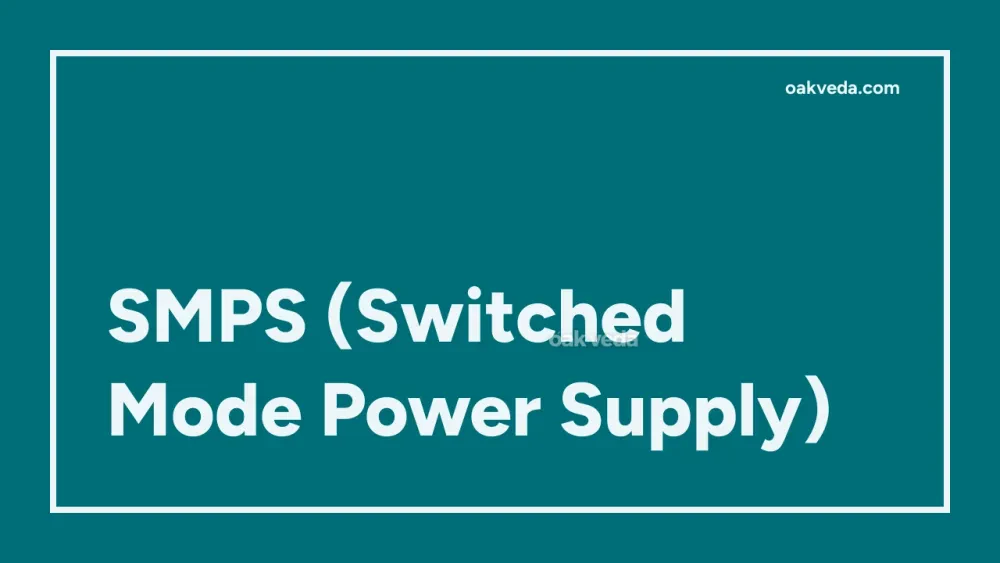
What is the Full Form of SMPS?
SMPS is an acronym widely used in the field of electronics and power management. The full form of SMPS is Switched Mode Power Supply, also known as Switching Mode Power Supply. This term refers to a highly efficient electronic power supply system that has revolutionized the way we power our devices.
What is Switched Mode Power Supply?
A Switched Mode Power Supply is an advanced electronic circuit designed to convert electrical power efficiently from one form to another. Unlike traditional linear power supplies, SMPS uses switching regulators to transfer electrical power, resulting in higher efficiency and compact design. These power supplies are essential components in various electronic devices, from computers and smartphones to industrial equipment.
Origin and Development of Switched Mode Power Supply
The concept of switched-mode power conversion dates back to the 1970s. As electronic devices became more complex and energy-demanding, engineers sought more efficient ways to manage power. The development of SMPS technology marked a significant breakthrough, offering a solution that was not only more efficient but also smaller and lighter than its predecessors.
How does Switched Mode Power Supply work?
The working principle of an SMPS is based on rapidly switching a power transistor between fully-on and fully-off states. This process involves several key steps:
- AC to DC Conversion: The input AC voltage is first rectified to DC.
- High-Frequency Switching: The DC is then switched on and off at a high frequency (typically 20 kHz to 300 kHz).
- Voltage Transformation: The switched power is passed through a high-frequency transformer to achieve the desired voltage level.
- Rectification and Filtering: The output is rectified and filtered to produce a clean DC voltage.
This method allows for efficient power conversion with minimal energy loss.
Types of Switched Mode Power Supplies
There are several types of SMPS, each suited for different applications:
- Buck Converter: Steps down voltage (reduces output voltage)
- Boost Converter: Steps up voltage (increases output voltage)
- Buck-Boost Converter: Can increase or decrease voltage as needed
- Flyback Converter: Commonly used in low-power applications
- Forward Converter: Suitable for higher power applications
Functions of Switched Mode Power Supply
The primary functions of an SMPS include:
- Voltage Regulation: Maintaining a stable output voltage despite fluctuations in input voltage or load.
- Power Conversion: Efficiently converting between AC and DC, or between different DC voltage levels.
- Electrical Isolation: Providing isolation between input and output in many designs.
- Multiple Outputs: Some SMPS designs can provide multiple output voltages from a single input.
Applications of Switched Mode Power Supply
SMPS technology finds applications in a wide range of devices and industries:
- Consumer Electronics: Computers, televisions, gaming consoles
- Mobile Devices: Smartphones, tablets, laptops
- Industrial Equipment: Factory automation systems, CNC machines
- Automotive: Electric vehicle charging systems, in-car electronics
- Telecommunications: Network equipment, base stations
- LED Lighting: Efficient drivers for LED lighting systems
Features of Switched Mode Power Supply
Key features that make SMPS stand out include:
- High Efficiency: Typically 60-70% efficient, much higher than linear power supplies
- Compact Size: Smaller and lighter than traditional power supplies
- Wide Input Range: Can often operate with a wide range of input voltages
- Low Heat Generation: Less energy wasted as heat due to higher efficiency
- Precise Voltage Regulation: Able to maintain stable output voltages
Benefits of Switched Mode Power Supply
The advantages of using SMPS technology are numerous:
- Energy Efficiency: Reduces power consumption and operating costs
- Space Saving: Compact design allows for smaller electronic devices
- Versatility: Can be designed for a wide range of power and voltage requirements
- Reliability: Modern SMPS designs offer improved reliability and longevity
- Cost-Effective: Despite initial complexity, mass production has made SMPS cost-effective
Limitations or Challenges of Switched Mode Power Supply
While SMPS offers many benefits, it also has some limitations:
- Complexity: More complex design compared to linear power supplies
- Electromagnetic Interference (EMI): Can generate high-frequency noise if not properly shielded
- Higher Initial Cost: More expensive to design and manufacture initially
- Potential for Failure: More components mean more potential points of failure
- Repair Difficulty: Specialized knowledge required for troubleshooting and repair
Future Developments in Switched Mode Power Supply Technology
The future of SMPS technology looks promising, with ongoing research and development focused on:
- Increased Efficiency: Pushing towards 90%+ efficiency in all power ranges
- Higher Power Density: Further miniaturization for even more compact designs
- Advanced Materials: Utilizing new semiconductor materials like Gallium Nitride (GaN)
- Smart Power Supplies: Integration of IoT and AI for intelligent power management
- Improved EMI Reduction: Developing techniques to minimize electromagnetic interference
FAQs on SMPS Full Form
-
What does SMPS stand for? SMPS stands for Switched Mode Power Supply.
-
How is SMPS different from a linear power supply? SMPS is more efficient, compact, and generates less heat compared to linear power supplies.
-
Can SMPS be used in high-power applications? Yes, SMPS can be designed for both low and high-power applications.
-
Is SMPS technology safe for sensitive electronics? When properly designed, SMPS is safe and widely used in sensitive electronic devices.
-
How does SMPS contribute to energy conservation? SMPS's high efficiency means less energy is wasted as heat, contributing to overall energy conservation.
In conclusion, the Switched Mode Power Supply (SMPS) has become an integral part of modern electronics, offering efficient, compact, and versatile power management solutions. As technology continues to advance, SMPS will undoubtedly evolve, playing a crucial role in powering the devices of tomorrow.
You may be interested in:
- HAL (Hindustan Aeronautics Limited): Full Form Explained
- SPSS (Statistical Package for the Social Sciences)
- CV (Curriculum Vitae): Full Form and Comprehensive Guide
- NMDC (National Mineral Development Corporation)
- SMS (Short Message Service): Full Form and Guide
- ITC (Indian Tobacco Company) Full Form

